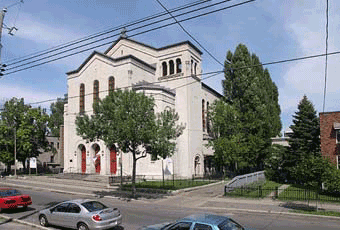It is, Marie Lafleche suggested, an appropriate motto for a workingman’s church: “And grant that to Thine honour, Lord, our daily toil may tend.”
The words, translated from a Latin hymn, are carved abovethealtarof St. Willibrord’s Church in working-class Verdun. The massive limestone building, on Willibrord St., about 50 metres northof WellingtonSt., has been ministering to the needs, spiritual and temporal, of proletarian parishioners for 97 years.
I was touring the church at the invitation of Dan Boyer, who pointed up toward the choir loft where he sang praises to the Almighty about 60 years ago. I had first met Boyer in a more secular setting: the parking lot of Sacred Heart School, where I would pass the time shooting the breeze with Dan, who was in charge of security, while waiting to give my daughter a lift home.
Over the years, Boyer often invited me to visit St. Willibrord’s and check out the church’s good work for its community. In writing one last column urging readers to contribute to the Gazette Christmas Fund, I ventured down to Verdun to see Christianity in action.
Highlights of the tour ranged from a finger bone to a room full of cardboard boxes.
The bone is in a reliquary at the side of the church. Father Stephen Otvos, who is 36 and has been the parish’s padre for 15 months, told me the relic is from St. Willibrord, a 7th-century Benedictine from Northumbria who Christianized the pagan tribes of Echternach, an area that is now Luxembourg.
The boxes, arrayed in a large basement room where St. Willibrord’s holds decidedly non-pagan dances, will be filled with food and distributed this Thursday to people who are now in need.
“We’re the only parish that delivers Christmas baskets,” Lafleche said. “They’re too heavy for people to carry from the church. We’re very blessed with young volunteers who have strong backs, because our recipients live on the second and third floors and in apartments without elevators.”
St. Willibrord’s is flanked by the kind of red-brick triplexes Lafleche described. Boyer remembers walking by them on his way to elementary school, exchanging pleasantries on a street where everyone knew each other and “we didn’t lock our doors, front or back.”
“Neighbours took care of each other,” Boyer recalls. “If someone had to go out for a couple hours, they’d bang on the door upstairs and the neighbour would watch the kids.
“During the war, people would trade food stamps and vouchers. If you didn’t use sugar, you’d swap with someone who did.
“The only time you see that spirit now is if there’s a crisis, like the Ice Storm.”
My friend Boyer had arranged for me to meet some people keeping that spirit alive -St. Willibrord volunteer parishioners Lafleche, Helen and Tony DiLallo, Ann Daye (secretary to Father Joseph Cameron, who was at St. Willibrord’s 35 years) and Yvonne Pelling, a British expat who works with the church’s youth group.
St. Willibrord’s funds its altruism through activities such a bazaar/raffle that raised $20,00 this year. Organizers mailed raffle books to former parishioners across the country, and there was a 78 per cent response rate from the Verdun diaspora.
People from far away still feel the community spirit of long ago. At one time (Lafleche, citing the stat, couldn’t remember exactly when) St. Willibrord’s was Canada’s largest English-speaking parish. Those second-and third-floor flats were occupied by multi-generational, mostly Irish and Quebecois families. Lafleche said the population density of Verdun was second, in North America, only to that of Brooklyn.
Sunday Mass filled the St. Willibrord pews with almost a thousand worshippers. That’s down to fewer than 300, but former parishioners still come back for sacraments -such as weddings, baptisms and a Christmas Eve midnight Mass (that will begin at 9:30). St. Willibrord’s is still a vital component of an evolving Verdun.
Christmas baskets, organized by Chris Ramdhanie and Angele Lafleche (Marie’s daughter) will be delivered with military precision between 1 and 5 on Thursday afternoon. Each cardboard box has an address and, in some cases, a special designation, such as “diabetic” or “dog” (the latter includes food for Fido). Side windows will be opened and boxes passed through them to waiting drivers by a bucket brigade, wearings hats, gloves and parkas because the room will be cold.
About 900 boxes will be delivered to almost 300 recipients. It is the biggest aid effort of theyearforSt. Willibrord’s, which prides itself on providing help to those in need.
Every Monday, Wednesday and Friday, Boyer and Sterling Smith, who has experience as a cook in the Canadian navy, prepare lunches in a subterranean soup kitchen. A chart on the wall lists attendance, ranging from 35 at the beginning of the month, when assistance cheques come in, to upward of 90 in the final week.
St. Willibrord’s also has a food bank, run by Lily and Emmett Cavanagh, a couple in their 80s. One of the goals for 2011, Helen DiLallo said, is boosting the nutritional value of food bags that currently contain staples such as peanut butter, canned beans and Kraft Dinner.
“We are called to serve our community,” Father Otvos says, “because our belief in God calls us to serve each other.”
And that is a belief to be practised and fostered -at Christmas and throughout the year.
Support the Christmas Fund or the charity of your choice. And happy holidays to all.
mboone@montrealgazette.com
By MIKE BOONE, The Gazette December 20, 2010
– – –
Christmas Fund
HOW YOU CAN HELP: Send donations to The Gazette Christmas Fund, PO Box 11057, Succ. Centre-Ville, Montreal, H3C 4Z4. Please use the coupon in today’s paper. Fax it to us at 514-987-2244, or drop off a donation at 1010 Ste. Catherine St. W., or phone us: 514-987- 2400, Monday to Friday, 9 a.m. to 2 p.m., or donate online:
www.christmasfund.com

